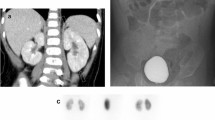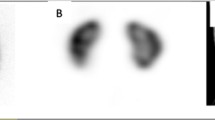Abstract
Objective
Static renal scintigraphy with Tc-99m dimercaptosuccinic acid (DMSA) is considered a scintigraphic gold standard in detection of post-inflammatory renal scars. Reports on usefulness of conventional summed (SUM) Tc-99 m mercaptoacetyltriglycine (MAG3) or Tc-99m ethylene dicysteine (EC) dynamic scintigraphic images in detection of renal scarring are ambiguous and some authors emphasize low sensitivity of this method. The work aimed at assessment of a diagnostic efficacy of parametric clearance images (PAR) generated from a dynamic renal scintigraphy in detection of renal scars.
Methods
A study group consisting of 80 children (56 girls, 24 boys, age 5–18 years) with recurrent urinary tract infections (UTI) and documented one to five incidents of APN—28 children, and with recurrent UTI of the lower part of the urinary tract only—52 children. Altogether 160 kidneys were evaluated. Static renal Tc-99m DMSA SPECT scintigraphy and after 2–4 days Tc-99m EC dynamic renal scintigraphy were performed in every patient not earlier than 6 months after the last documented incident of UTI. PAR images generated from a dynamic renal scintigraphy acquired between 40 and 140 s. generated by in-house developed software and SUM images obtained in the same time period were compared with a reference Tc-99m DMSA SPECT study.
Results
For all kinds of images (SPECT, PAR and SUM), high indices of reproducibility were obtained—89 % (κ = 0.80), 88 % (κ = 0.78) and 89 % (κ = 0.73). Agreement in a Howard scale of a reference method (SPECT) with PAR and SUM methods amounted to 83 and 64 %, respectively (p = 0.004). Sensitivity and accuracy of PAR method as compared with SUM method were significantly higher: 89 vs. 49 % (p < 0.0001) and 88 vs. 73 % (p = 0.002), and specificity was slightly lower: 88 vs. 93 % (p = 0.043). SPECT and PAR methods revealed higher incidence of renal scars than a SUM method in patients with documented incident(s) of APN—64, 68 and 39 %, p = 0.009 and 0.008, respectively.
Conclusion
PAR images generated from a dynamic renal scintigraphy improved sensitivity of detection of renal scars as compared with SUM images, providing a high reproducibility and diagnostic efficacy, similar to that of Tc-99m DMSA, in detection of post-inflammatory renal scarring.


Similar content being viewed by others
References
Faust WC, Diaz M, Pohl HG. Incidence of post-pyelonephritic renal scarring: a meta-analysis of the dimercaptosuccinic acid literature. J Urol. 2009;181:290–8.
Leroy S, Chalumeau M, Ulinski M, Dubos F, Sergent-Alaoui A, Merzoug V, et al. Impressive renal damage after acute pyelonephritis in a child. Pediatr Nephrol. 2010;25:1365–8.
Bailey RR. The relationship of vesico-ureteric reflux to urinary tract infection and chronic pyelonephritis–reflux nephropathy. Clin Nephrol. 1973;1:132–41.
Smith EA. Pyelonephritis, renal scarring, and reflux nephropathy: a pediatric urologist’s perspective. Pediatr Radiol. 2008;38(Suppl1):76–82.
Jacobson SH, Eklof O, Eriksson CG, Lins LE, Tidgren B, Winberg J. Development of hypertension and uraemia after pyelonephritis in childhood: 27 year follow up. BMJ. 1989;299:703–6.
Sinha MD, Gibson P, Kane T, Lewis MA. Accuracy of ultrasonic detection of renal scarring in different centres using DMSA as the gold standard. Nephrol Dial Transplant. 2007;22:2213–6.
Rossleigh MA. Scintigraphic imaging in renal infections. Q J Nucl Med Mol Imaging. 2009;53:72–7.
Annals of the ICRP. Publication 106. Radiation dose to patients from radiopharmaceuticals. Amsterdam: Elsevier Ltd; 2009.
Atasever T, Ozkaya O, Abamor E, Söylemezoğlu O, Buyan N, Unlü M. 99mTc ethylene dicysteine scintigraphy for diagnosing cortical defects in acute pyelonephritis:a comparative study with 99mTc dimercaptosuccinic acid. Nucl Med Commun. 2004;25:967–70.
Mueller-Suur R, Heanadler L, Zachrisson I, Mesko L. Combination of Tc-99m MAG3 gamma camera renography and TC-99m DMSA scans for evaluation of acute pyelonephritis in children. Nucl Med Commun (abstract). 1992;13:375.
Pietrzak-Stelmasial E, Frieske I, Bieńkiewicz M, Woźnicki W, Kowalewska-Pietrzak M, Bubińska K, et al. Assessment of clinical usefulness of parametric clearance images in diagnosis of kidney cicatrisation in children with chronic infections of the urinary tract. Nucl Med Rev Cent East Eur. 2010;13:8–14.
Gordon I, Anderson PJ, Lythgoe M, Orton M. Can TC-99m Mercaptoacetylotriglicerine replace Tc-99m DMSA in the exclusion of a focal renal defect? J Nucl Med. 1992;33:2090–3.
Anderson PJ, Todd-Prokopek A, Orton MJ. Can a functional image of MAG3 renal clearance replace DMSA in the diagnosis of a renal scar? In: Taylor A, Nally JV, Thomson H, editors. Radionuclides in nephrourology. Reston: Society of Nuclear Medicine; 1997. p. 105–11.
Soylu A, Demir BK, Türkmen M, Bekem Ö, Saygi M, Cakmakci H, et al. Predictors of renal scar in children with urinary infection and vesicoureteral reflux. Pediatr Nephrol. 2008;23:2227–32.
Burns MW, Burns JL, Krieger JN. Pediatric urinary tract infection. Diagnosis, classification and significance. Pediatr Clin North Am. 1987;34:1111–20.
Piepsz A, Ham HR. Pediatric applications of renal nuclear medicine. Semin Nucl Med. 2006;36:16–35.
Mandell GA, Eggli DF, Gilday DL, Heyman S, Leonard JC, Miller JH, et al. Procedure guideline for renal cortical scintigraphy in children. Society of Nuclear Medicine. J Nucl Med. 1997;38:1644–6.
Rutland MD. A comprehensive analysis of renal DTPA studies. I. Theory and normal values. Nucl Med Commun. 1985;6:11–20.
Howard RG, Roebuck DJ, Yeung PA, Chan KW, Metreweli C. Vesicoureteric reflux and renal scarring in Chinese children. Brit J Radiol. 2001;74:331–4.
Piepsz A, Blaufox MD, Gordon I, Granerus G, Majd M, O’reilly P, et al. Consensus on renal cortical scintigraphy in children with urinary tract infection. Semin Nucl Med. 1999;2:160–74.
Abdülrezzak Ü, Erdoğan Z, Kula M. Evaluation of renal parenchymal defects with 99mTechnetium mercaptoacetyltriglycine scintigraphy using a modified grading and scoring system: comparison with 99mTechnetium dimercaptosuccinic acid. Erciyes Med J. 2013;35:18–23.
Kibar M, Yapar Z, Noyn A, Anarat A. Technetium-99m-N, N-ethylenedicysteine and Tc-99m DMSA scintigraphy in the evaluation of renal parenchymal abnormalities in children. Ann Nucl Med. 2003;17:219–25.
Narayana C, Tripathi M, Kumar A, Gowda NK, Phom H, Chandra P, et al. Technetium-99m-L, L-ethylenedicysteine renal scan as a single-modality investigation for the evaluation of renal morphology and function:a comparative study with technetium-99m-dimercaptosuccinic acid. Nucl Med Commun. 2004;25:743–7.
Frieske I, Pietrzak-Stelmasiak E, Bieńkiewicz M, Surma MJ, Kuśmierek J. Parametric kidney scintigrams and conventional summation images—reproducibility of semiquantitative image evaluation. Nucl Med Rev Cent East Eur. 2008;11:22–5.
Caglar M, Kiratli PO, Karabulut E. Inter-and intraobserver variability of 99mTc-DMSA renal scintigraphy:impact of oblique views. J Nucl Med Technol. 2007;35:96–9.
Shanon A, Feldman W, McDonald P, Martin DJ, Matzinger MA, Shillinger JF, et al. Evaluation of renal scars by technetium-labeled dimercaptosuccinic acid scan, intravenous urography, and ultrasonography: a comparative study. J Pediatr. 1992;120:399–403.
Lim R. Vesicoureteral reflux and urinary tract infection: evolving practices and current controversies in pediatric imaging. AJR Am J Roentgenol. 2009;192:1197–208.
Pecile P, Miorin E, Romanello C, Vidal E, Contardo M, Valent F, et al. Age-related renal parenchymal lesions in children with first febrile urinary tract infections. Pediatrics. 2009;124:23–9.
Foxman B. Epidemiology of urinary tract infections: incidence, morbidity and economic costs. Am J Med. 2002;113(Suppl 1A):5S–13S.
Feld LG, Mattoo TK. Urinary tract infections and vesicoureteral reflux in infants and children. Pediatr Rev. 2010;31:451–63.
Acknowledgments
Authors wish to thank dr Magdalena Kowalewska Pietrzak, dr Krystyna Bubińska and dr Małgorzata Rumieniecka from the Outpatient Clinic of Nephrology in Janusz Korczak Regional Hospital in Łódź for an effective cooperation.
Conflict of interest
No potential conflicts of interest were disclosed.
Author information
Authors and Affiliations
Corresponding author
Rights and permissions
About this article
Cite this article
Kuśmierek, J., Pietrzak-Stelmasiak, E., Bieńkiewicz, M. et al. Diagnostic efficacy of parametric clearance images in detection of renal scars in children with recurrent urinary tract infections. Ann Nucl Med 29, 313–318 (2015). https://doi.org/10.1007/s12149-014-0944-4
Received:
Accepted:
Published:
Issue Date:
DOI: https://doi.org/10.1007/s12149-014-0944-4




